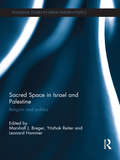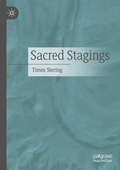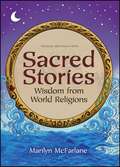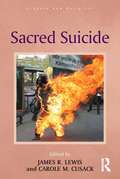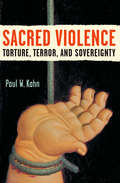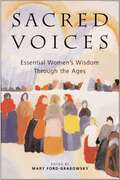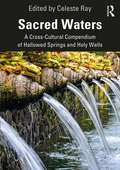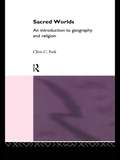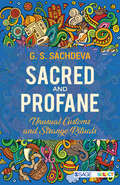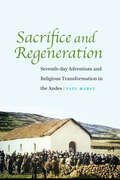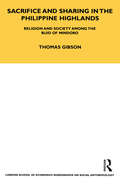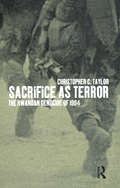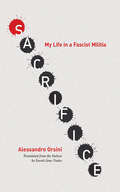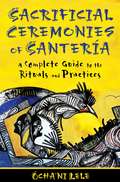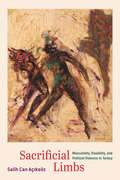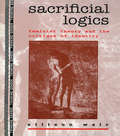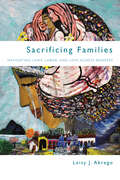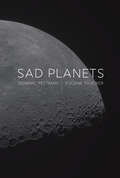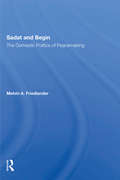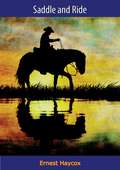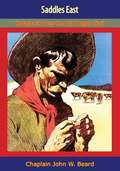- Table View
- List View
Sacred Space in Israel and Palestine: Religion and Politics (Routledge Studies in Middle Eastern Politics)
by Yitzhak Reiter Marshall J. Breger Leonard HammerReligion and religious nationalism have long played a central role in many ethnic and national conflicts, and the importance of religion to national identity means that territorial disputes can often focus on the contestation of holy places and sacred territory. Looking at the case of Israel and Palestine, this book highlights the nexus between religion and politics through the process of classifying holy places, giving them meaning and interpreting their standing in religious and civil law, within governmental policy, and within international and local communities. Written by a team of renowned scholars from within and outside the region, this book follows on from Holy Places in the Israeli-Palestinian Conflict: Confrontation and Co-existence to provide an insightful look into the politics of religion and space. Examining Jerusalem’s holy basin from a variety of perspectives and disciplines, it provides unique insights into the way Jewish, Christian and Muslim authorities, scholars and jurists regard sacred space and the processes, grass roots and official, by which spaces become holy in the eyes of particular communities. Filling an important gap in the literature on Middle East peacemaking, the book will be of interest to scholars and students of the Middle East conflict, conflict resolution, political science, urban studies and history of religion.
Sacred Stagings
by Timm SieringLiturgical acts can be understood as performances. In this context, the focus is on the specific stagings within the diverse landscape of worship services, prompting an analysis that primarily explores the hermeneutics of individual liturgical practices and artifacts. The understanding of worship in this work is not primarily derived from a semiotic interpretation of worship based on theater theories. Rather, it becomes evident that worship services unfold their character as a cultural practice sui generis especially where they fundamentally differ from theater by presenting themselves as something other than everyday life. Guided by a concept of performativity developed primarily in religious education, a distinction is made between the factual and tactical design of liturgical processes. Following some terminological considerations, this is first illustrated using the example of the entrance rite. Here, the intentions and effects of individual traditional formulations and their situational adaptations are compared. Finally, three case studies focus on musical and pop-cultural approaches to an understanding of worship that, when thought of from the perspective of music, can be described as &“liturgicking.&”
Sacred Steel: Inside an African American Steel Guitar Tradition (Music in American Life)
by Robert StoneIn this book, Robert L. Stone follows the sound of steel guitar into the music-driven Pentecostal worship of two related churches: the House of God and the Church of the Living God. A rare outsider who has gained the trust of members and musicians inside the church, Stone uses nearly two decades of research, interviews, and fieldwork to tell the story of a vibrant musical tradition that straddles sacred and secular contexts. Most often identified with country and western bands, steel guitar is almost unheard of in African American churches--except for the House of God and the Church of the Living God, where it has been part of worship since the 1930s. Sacred Steel traces the tradition through four generations of musicians and in some two hundred churches extending across the country from Florida to California, Michigan to Alabama. Presenting detailed portraits of musical pioneers such as brothers Troman and Willie Eason and contemporary masters such as Chuck Campbell, Glenn Lee, and Robert Randolph, Stone expertly outlines the fundamental tensions between sacred steel musicians and church hierarchy. In this thorough analysis of the tradition, Stone explores the function of the music in church meetings and its effect on the congregations. He also examines recent developments such as the growing number of female performers, the commercial appeal of the music, and younger musicians' controversial move of the music from the church to secular contexts.
Sacred Stories: Wisdom from World Religions
by Marilyn Mcfarlane Caroline O. BergThis comprehensive collection of timeless and powerful stories puts the wisdom of world religions in the hands of young readers.When attempting to find a simple, engaging, and unbiased approach to world religions for her own family, Marilyn McFarlane discovered such a book did not exist. Understanding how important it is for children to build both respect for and knowledge of a variety of religions, regardless of their own faith, McFarlane created Sacred Stories: Wisdom from World Religions.Each captivating story and accompanying sidebar facts and spot illustrations brings to life the key tenets of a particular belief system, while the comprehensive glossary and resource list enable readers to expand their explorations. Including easy-to-understand descriptions and essential stories from Buddhism, Christianity, Hinduism, Islam, Judaism, Native American, and Sacred Earth, Sacred Stories is perfect for parents and teachers who want to expand young readers' understanding of world traditions.The simple, informative, unbiased language of Sacred Stories, combined with its comprehensive resource list and glossary, makes it an ideal learning tool for teachers, librarians, and other educators.
Sacred Stories: Wisdom from World Religions
by Marilyn McfarlaneThis comprehensive collection of timeless and powerful stories puts the wisdom of world religions in the hands of young readers.When attempting to find a simple, engaging, and unbiased approach to world religions for her own family, Marilyn McFarlane discovered such a book did not exist. Understanding how important it is for children to build both respect for and knowledge of a variety of religions, regardless of their own faith, McFarlane created Sacred Stories: Wisdom from World Religions.Each captivating story and accompanying sidebar facts and spot illustrations brings to life the key tenets of a particular belief system, while the comprehensive glossary and resource list enable readers to expand their explorations. Including easy-to-understand descriptions and essential stories from Buddhism, Christianity, Hinduism, Islam, Judaism, Native American, and Sacred Earth, Sacred Stories is perfect for parents and teachers who want to expand young readers' understanding of world traditions.The simple, informative, unbiased language of Sacred Stories, combined with its comprehensive resource list and glossary, makes it an ideal learning tool for teachers, librarians, and other educators.
Sacred Suicide (Routledge New Religions)
by Carole M. CusackThe label 'Suicide Cults' has been applied to a wide variety of different alternative religions, from Jonestown to the Solar Temple to Heaven's Gate. Additionally, observers have asked if such group suicides are in any way comparable to Islamist suicide terrorism, or to historical incidents of mass suicide, such as the mass suicide of the ancient community of Masada. Organizationally and ideologically diverse, it turns out that the primary shared trait of these various groups is a common stereotype of religion as an irrational force that pushes fanatics to undertake acts of suicidal violence. Offering a valuable perspective on New Religious Movements and on religion and violence, Sacred Suicide brings together contributions from a diverse range of international scholars of sociology, religious studies and criminology.
Sacred Violence: Torture, Terror, and Sovereignty
by Paul W. KahnInSacred Violence, the distinguished political and legal theorist Paul W. Kahn investigates the reasons for the resort to violence characteristic of premodern states. In a startling argument, he contends that law will never offer an adequate account of political violence. Instead, we must turn to political theology, which reveals that torture and terror are, essentially, forms of sacrifice. Kahn forces us to acknowledge what we don't want to see: that we remain deeply committed to a violent politics beyond law. Paul W. Kahn is Robert W. Winner Professor of Law and the Humanities at Yale Law School and Director of the Orville H. Schell, Jr. Center for International Human Rights. Cover Illustration: "Abu Ghraib 67, 2005" by Fernando Botero. Courtesy of the artist and the American University Museum.
Sacred Voices: Essential Women's Wisdom Through the Ages
by Mary Ford-GrabowskyMoving chronologically through millennia of women's history from the earliest times to the present, this unique collection contains writings from over 173 of the world's women sages and saints. Containing poetry, prayers, chants, meditations, and contemplative prose from all great religious traditions, this treasure trove gathers together for the first time the best of women's spiritual wisdom.Women's spiritual experience has been suppressed through much of modern history and is only now been recovered in its full richness. This anthology contains writings from hundreds of women from the past five millennia and a wide range of cultures. The collection encompasses all areas of women's sacred experience from the most radically mystical encounters with the divine-including visions, locutions, and auditions-to simply daily awareness of the holy in all things.
Sacred Waters: A Cross-Cultural Compendium of Hallowed Springs and Holy Wells
by Celeste RayDescribing sacred waters and their associated traditions in over thirty countries and across multiple time periods, this book identifies patterns in panhuman hydrolatry. Supplying life’s most basic daily need, freshwater sources were likely the earliest sacred sites, and the first protected and contested resource. Guarded by taboos, rites and supermundane forces, freshwater sources have also been considered thresholds to otherworlds. Often associated also with venerated stones, trees and healing flora, sacred water sources are sites of biocultural diversity. Addressing themes that will shape future water research, this volume examines cultural perceptions of water’s sacrality that can be employed to foster resilient human–environmental relationships in the growing water crises of the twenty-first century. The work combines perspectives from anthropology, archaeology, classics, folklore, geography, geology, history, literature and religious studies.
Sacred Worlds: An Introduction to Geography and Religion
by Chris ParkThis book, the first in the field for two decades, looks at the relationships between geography and religion. It represents a synthesis of research by geographers of many countries, mainly since the 1960s. No previous book has tackled this emerging field from such a broad, interdisciplinary perspective, and never before have such a variety of detailed case studies been pulled together in so comparative or illuminating a way. Examples and case studies have been drawn from all the major world religions and from all continents from both a historical and contemporary perspective. Major themes covered in the book include the distribution of religion and the processes by which religion and religious ideas spread through space and time. Some of the important links between religion and population are also explored. A great deal of attention is focused on the visible manifestations of religion on the cultural landscape, including landscapes of worship and of death, and the whole field of sacred space and religious pilgrimage.
Sacred and Profane: Unusual Customs and Strange Rituals
by G.S. SachdevaThe battle between scientific temper and superstition has raged since ages. One may believe that unusual rituals and customs are extinct in the times of artificial intelligence and bots, but it is far from the truth as this book will prove. As bizarre as it might seem, in France one can marry a dead person, and in Africa a married woman can marry another married woman as a practical way of solving the social problem of old-age neglect. This book is a collection of unusual superstitions, rituals and customs that are practiced by ordinary people all around the world. It should be read to build awareness about these rituals and to know about the many shades of faith in this world we inhabit. Sacred and Profane is not a religious exposition or vindication of rituals; it aims to arouse human curiosity about such beliefs while shedding light on some important social issues.
SacredSecular: Contemplative Cultural Critique
by Lata ManiWhat would it mean to conceive of the sacred as a source of knowledge that is as vital as the secular? What insights does a contemplative approach yield in analysing neoliberal globalisation or Hindu fundamentalism? Is a dew drop sacred, or is it secular? In today’s charged atmosphere many believe that the sacred is best kept firmly apart from the realm of the secular. SacredSecular: Contemplative Cultural Critique offers a contrasting view. It argues that the two are indivisible and can productively interweave in illuminating key contemporary issues. Essays investigate the quotidian (trash, cut flowers), the philosophical (advaita, karma), the economic (work, globalisation) and the political (war, violence). Mani invites us to rethink the prevailing view that secularism is the only progressive response to religious authoritarianism. SacredSecular proposes a conceptual approach in which body, mind, heart, nature, matter and spirit are not merely equals, but equally crucial to crafting an inclusive vision and practice. This book addresses several audiences: scholars of contemporary Indian society and culture, spiritual practitioners striving to integrate their practice with their politics, and all those interested in contemplating the present and what it portends for our collective future.
Sacrifice and Regeneration: Seventh-day Adventism and Religious Transformation in the Andes
by Yael MabatAt the dawn of the twentieth century, while Lima&’s aristocrats hotly debated the future of a nation filled with &“Indians,&” thousands of Aymara and Quechua Indians left the pews of the Catholic Church and were baptized into Seventh-day Adventism. One of the most staggering Christian phenomena of our time, the mass conversion from Catholicism to various forms of Protestantism in Latin America was so successful that Catholic contemporaries became extremely anxious on noticing that parts of the Indigenous population in the Andean plateau had joined a Protestant church. In Sacrifice and Regeneration Yael Mabat focuses on the extraordinary success of Seventh-day Adventism in the Andean highlands at the beginning of the twentieth century and sheds light on the historical trajectories of Protestantism in Latin America. By approaching the religious conversion among Indigenous populations in the Andes as a multifaceted and dynamic interaction between converts, missionaries, and their social settings and networks, Mabat demonstrates how the religious and spiritual needs of converts also brought salvation to the missionaries. Conversion had important ramifications on the way social, political, and economic institutions on the local and national level functioned. At the same time, socioeconomic currents had both short-term and long-term impacts on idiosyncratic religious practices and beliefs that both accelerated and impeded religious change. Mabat&’s innovative historical perspective on religious transformation allows us to better comprehend the complex and often contradictory way in which Protestantism took shape in Latin America.
Sacrifice and Sharing in the Philippine Highlands: Religion and Society among the Buid of Mindoro
by Thomas P. GibsonThis book is about the relationship between the Buid value system and their history of resistance to the lowland world.
Sacrifice as Terror: The Rwandan Genocide of 1994 (Global Issues)
by Christopher C. TaylorIn the early months of 1994, it became clear that the government of Rwanda had not acted in good faith in signing peace accords with its adversary, the Rwandan Patriotic Front. Acts of government-sponsored violence grew more frequent. The author of this book, who at that point was conducting fieldwork in Rwanda, on several occasions found either himself or the Rwandans accompanying him threatened with, or sustaining, bodily harm. Finally, active hostilities between the antagonists escalated on April 7, 1994, just hours after the Rwandan President's plane was shot down. During the author's evacuation from Rwanda in the months following, he interviewed many survivors. This book, the outcome of the author's experiences during the conflict, is an attempt to understand the atrocities committed during the 1994 genocide in Rwanda in which nearly one million people, mostly of Tutsi ethnicity, were slaughtered in less than four months. Beyond this, the author shows that political and historical analyses, while necessary in understanding the violence, fail to explain the forms that the violence took and the degree of passion that motivated it. Instead, Rwandan ritual and practices related to the body are revelatory in this regard, as the body is the ultimate tablet upon which the dictates of the nation-state are inscribed. One rather bizarre example of this is that Hutu extremists often married or had sexual relations with Tutsi women who, according to the Hamitic hypothesis, were said to be sexually alluring. Their mixed-race offspring were not exempt from the genocide. Finally, and perhaps most importantly in light of the recent resurgence of violence, the author advances hypotheses about how the violence in Rwanda and Burundi might be transcended.
Sacrifice: My Life in a Fascist Militia
by Alessandro OrsiniAlessandro Orsini is one of Italy's premier analysts of political extremism. His investigation of the beliefs and mind-sets of Europe's political fringe has largely focused on anarchist and far-left groups, but in Sacrifice he turns his inquiry to the rapidly expanding neofascist movement. He joined local groups of a neofascist organization he names Sacrifice in two neighboring cities with very different political cultures. In this gripping, "insider" book, which features dialogues with various militia members, Orsini shows how fascists live day to day, how they understand their world, and how they build a parallel universe in which the correctness and probity of their attitudes are clear. Orsini describes the long, troubled process by which these two groups slowly accepted him as an investigatoractivist and later expelled him for his ideologically uncommitted stance and refusal to subject his observations to censorship. His activities as a fascist were often mundane: leafleting, distributing food parcels to the indigent, and attending public rallies. In Sacrifice, Orsini describes from within the masculine ethos of the militias, the groups' relations with local police and politicians, and the central role of violence and anticommunist actions in building a sense of fascist community.
Sacrificial Ceremonies of Santería
by Ócha'Ni LeleThe first book to explore the history, methods, and thinking behind sacrifice in the growing Santería faith • Explains the animal sacrifice ceremony in step-by-step detail • Shares the ancient African sacred stories that reveal the well-thought-out metaphysics and spirituality behind the practice of animal sacrifice • Chronicles the legal fight all the way to its 1993 U.S. Supreme Court victory to establish legal protection for the Santería faith and its practitioners Tackling the biggest controversy surrounding his faith, Santería priest Ócha’ni Lele explains for the first time in print the practice and importance of animal sacrifice as a religious sacrament. Describing the animal sacrifice ceremony in step-by-step detail, including the songs and chants used, he examines the thinking and metaphysics behind the ritual and reveals the deep connections to the odu of the diloggún--the source of all practices in this Afro-Cuban faith. Tracing the legal battle spearheaded by Oba Ernesto Pichardo, head of the Church of the Lukumi of Babaluaiye, over the right to practice animal sacrifice as a religious sacrament, Lele chronicles the fight all the way to its 1993 U.S. Supreme Court victory, which established legal protection for the Santería faith and its practitioners. Weaving together oral fragments stemming from the ancient Yoruba of West Africa, the author reconstructs their sacred stories, or patakís, that demonstrate the well-thought-out metaphysics and spirituality behind the practice of animal sacrifice in the Yoruba and Santería religion, including explanations about why each animal can be regarded as food for both humans and the orisha as well as how sacrifice is not limited to animals. Shedding light on the extraordinary global growth of this religion over the past 50 years, Lele’s guide to the sacrificial ceremonies of Santería enables initiates to learn proper ceremony protocol as well as gives outsiders a glimpse into this most secretive world of the santeros.
Sacrificial Limbs: Masculinity, Disability, and Political Violence in Turkey
by Salih Can AçıksözSacrificial Limbs chronicles the everyday lives and political activism of disabled veterans of Turkey’s Kurdish war, one of the most volatile conflicts in the Middle East. Through nuanced ethnographic portraits, Açiksöz examines how veterans’ experiences of war and disability are closely linked to class, gender, and ultimately the embrace of ultranationalist right-wing politics. Bringing the reader into military hospitals, commemorations, political demonstrations, and veterans’ everyday spaces of care, intimacy, and activism, Sacrificial Limbs provides a vivid analysis of the multiple and sometimes contradictory forces that fashion veterans’ bodies, political subjectivities, and communities. It is essential reading for students and scholars interested in anthropology, masculinity, and disability.
Sacrificial Logics: Feminist Theory and the Critique of Identity (Thinking Gender)
by Allison WeirAllison Weir sets forth a concept of identity which depends on an acceptance of nonidentity, difference, and connection to others, defined as a capacity to participate in a social world. Weir argues that the equation of identity with repression and domination links "relational feminists" like Nancy Chodorow, who equate self-identity with the repression of connection to others, and poststructuralist feminists like Judith Butler, who view any identity as a repression of nonidentity or difference. Weir traces this conception of identity as domination back to Simone de Beauvoir's theories of the relation of self and other.
Sacrificing Families: Navigating Laws, Labor, and Love Across Borders
by Leisy J. AbregoWidening global inequalities make it difficult for parents in developing nations to provide for their children, and both mothers and fathers often find that migration in search of higher wages is their only hope. Their dreams are straightforward: with more money, they can improve their children's lives. But the reality of their experiences is often harsh, and structural barriers—particularly those rooted in immigration policies and gender inequities—prevent many from reaching their economic goals. Sacrificing Families offers a first-hand look at Salvadoran transnational families, how the parents fare in the United States, and the experiences of the children back home. It captures the tragedy of these families' daily living arrangements, but also delves deeper to expose the structural context that creates and sustains patterns of inequality in their well-being. What prevents these parents from migrating with their children? What are these families' experiences with long-term separation? And why do some ultimately fare better than others? As free trade agreements expand and nation-states open doors widely for products and profits while closing them tightly for refugees and migrants, these transnational families are not only becoming more common, but they are living through lengthier separations. Leisy Abrego gives voice to these immigrants and their families and documents the inequalities across their experiences.
Sad Planets
by Eugene Thacker Dominic Pettman“Everything is sad,” wrote the Ancient poets. But is this sadness merely a human experience, projected onto the world, or is there a gloom attributable to the world itself? Could the universe be forever weeping the “tears of things”? In this series of meditations, Dominic Pettman and Eugene Thacker explore some of the key “negative affects” – both eternal and emergent – associated with climate change, environmental destruction, and cosmic solitude. In so doing they unearth something so obvious that it has gone largely unnoticed: the question of how we should feel about climate change. Between the information gathered by planetary sensors and the simple act of breathing the air, new unsettling moods are produced for which we currently lack an adequate language. Should we feel grief over the loss of our planet? Or is the strange feeling of witnessing mass extinction an indicator that the planet was never “ours” to begin with? Sad Planets explores this relationship between our all-too-human melancholia and a more impersonal sorrow, nestled in the heart of the cosmic elements.Spanning a wide range of topics – from the history of cosmology to the “existential threat” of climate change – this book is a reckoning with the limits of human existence and comprehension. As Pettman and Thacker observe, never before have we known so much about the planet and the cosmos, and yet never before have we felt so estranged from that same planet, to say nothing of the stars beyond.
Sadat And Begin: The Domestic Politics Of Peacemaking
by Melvin A FriedlanderThe architects of the Camp David process expected their efforts to become a broad and inclusive framework for peace in the Middle East. Dr. Friedlander's book demonstrates how domestic factors affecting policy decisions made in both Cairo and Jerusalem prevented Sadat and Begin from embracing a structure that would yield a more comprehensive arrangement. Sadat, for example, confronted an antipeace movement in Egypt, strengthened by then-Vice President Mubarak's ties to the military-security establishment and his alliance with members of the Arab nation's diplomatic corps. Begin was opposed by Israeli conservatives who saw the Camp David formulas as leading to a peace that would jeopardize Israel's security. Both leaders, Dr. Friedlander concludes, were able ultimately to guide their nations toward approval of the peace initiative primarily because of their mastery of techniques of domestic intra-elite bargaining.
Saddle and Ride
by Ernest HaycoxA MAN OF PEACE—A MAN OF VENGEANCE: A SMOLDERING BLOOD-FEUD BURSTS INTO BLAZING RANGE WAR…A big man with an even bigger hankering for land and power, cattleman Ben Herendeen and his homemade posse weren’t content with just planting a few two bit rustlers six feet under. Soon every drifter, homesteader, and haywire rider who stood in their way would get a taste of the vigilantes’ murderous justice. Only one law was going to rule in War Pass—Ben Herendeen’s law!Rancher Clay Morgan had hated Big Ben since boyhood. Now all his friends were either riding with Herendeen—or running from him. Lines were being drawn, and it looked like Morgan was standing on the losing side. Death was staking a claim in the high, lonesome hills, but Clay Morgan’s blazing six-guns were fixing to put an end to the lifelong feud—one way or the other!
Saddles East: Horseback Over the Old Oregon Trail
by Chaplain John W. BeardSaddles East: Horseback Over the Old Oregon Trail, a book by the WWI ‘fighting chaplain,’ John W. Beard, was first published in 1949. It is an informal narrative of a horseback ride in modern times over the famous covered-wagon route of the pioneers. For countless ages the Red Man knew this trail. In the fullness of time the trapper, the mountain man, the fur trader found it and lived their life among its reaches. The seeker after gold hastened over it. The priest with the cross and the missionary with his Bible made it beautiful with their message of life and peace. The hardy pioneer and he eager emigrant traveled it into the land of their dreams. The pony express rider flashed his phantom; the Overland Stage rumbled by. The soldier built his forts. Who knows even a little of the story of the old trail and does not wish to know it all? Who has ever traveled over any part of the old trail and does not long to travel over all of it, even to its very end? Who has ever heard the story of wagons west, who does not want to take Saddles East and ride into the sunrise, as the pioneers rode into the sunset?
Sadeq Hedayat: His Work and his Wondrous World (Iranian Studies)
by Homa KatouzianFeaturing contributions from leading scholars of Iranian studies and / or comparative literature, this edited comprehensive and critical edited collection provides detailed scholarly analysis of Hedayat's life and work using a variety of methodological and conceptual approaches. Hedayat is the author of The Blind Owl, the most famous Persian novel both in Iran and in Europe and America. Many of his short stories are in a critical realist style and are regarded as among some of the best written in twentieth century Iran. But his most original contribution was the use of modernist, more often surrealist, techniques in Persian fiction. Thus, he was not only a great writer, but also the founder of modernism in Persian fiction. Yet both Hedayat’s life and his death came to symbolize much more than leading writers would normally claim. He still towers over modern Persian fiction and will remain a highly controversial figure so long as the clash of the modern and the traditional, the Persian and the European, and the religious and the secular, has not led to a synthesis and a consensus.
